
Say your computer is working day and night, solving complex puzzles, and in return, you earn digital money. Sounds like we are already living in the future, right?
That’s exactly what crypto mining is all about. It is like being part of a treasure hunt, but instead of using maps, you use powerful machines and algorithms. Let’s understand it step by step.
At its core, crypto mining is the process of authenticating transactions on a blockchain network and adding them to the ledger. In return for this work, miners are rewarded with cryptocurrency.
You can think of it as a decentralized bank system where everyone’s a teller, and the system rewards those who do the work.
You’ve probably heard of Bitcoin, right?
It is the most popular cryptocurrency and also the first one to introduce the concept of mining. But mining isn’t exclusive to Bitcoin; other cryptocurrencies like Ethereum (before it shifted to proof-of-stake), Litecoin, and Monero also rely on mining.
Okay, let’s simplify this.
These puzzles are hard to crack but easy to verify. This keeps the system secure and ensures no one can cheat.
Let’s talk about the “why” first.
But, mining isn’t just about plugging in a machine and getting rich overnight. There’s a learning curve, some investment, and ongoing costs to consider.
Not all mining is the same. Here are the main types:
Alright, ready to jump in? Here’s what you need to begin:
Let’s get real. Mining is not a guaranteed profit machine.
Factors that affect profitability:
Before you start, use a mining calculator to estimate profits. Websites like WhatToMine can help.
Begin with a single GPU setup to test the waters.
Learn about the coin you want to mine. Different coins have different requirements and profitability.
Online forums and groups are treasure troves of advice. Check out Reddit’s r/cryptomining or Discord groups.
The crypto world changes fast. Keep an eye on market trends, mining difficulty, and new technologies.
Don’t put all your eggs in one basket. Mine different coins to spread risk.
The landscape is evolving. Here are some trends to watch:
Crypto mining can be rewarding but isn’t for everyone. If you enjoy learning about technology, have access to affordable electricity, and don’t mind some upfront investment, it’s worth exploring.
Start small. Experiment. Learn from mistakes. And remember, it’s not just about making money—it’s about being part of a revolutionary technology that’s shaping the future of finance.
Crypto mining involves solving complex puzzles on a blockchain to authenticate transactions and earn cryptocurrency rewards.
Profitability depends on hardware costs, electricity, crypto prices, and network difficulty. Use mining calculators to estimate earnings.
You’ll need mining hardware (GPU or ASIC), mining software, a crypto wallet, stable electricity, and internet connection for mining.
Types include CPU mining, GPU mining, ASIC mining, cloud mining, and mobile mining, each with varying costs and performance.
Challenges include high electricity costs, hardware expenses, heat/noise, competition from large farms, and regulatory issues.
CoinPedia has been delivering accurate and timely cryptocurrency and blockchain updates since 2017. All content is created by our expert panel of analysts and journalists, following strict Editorial Guidelines based on E-E-A-T (Experience, Expertise, Authoritativeness, Trustworthiness). Every article is fact-checked against reputable sources to ensure accuracy, transparency, and reliability. Our review policy guarantees unbiased evaluations when recommending exchanges, platforms, or tools. We strive to provide timely updates about everything crypto & blockchain, right from startups to industry majors.
All opinions and insights shared represent the author's own views on current market conditions. Please do your own research before making investment decisions. Neither the writer nor the publication assumes responsibility for your financial choices.
Sponsored content and affiliate links may appear on our site. Advertisements are marked clearly, and our editorial content remains entirely independent from our ad partners.
Finding a crypto asset that can deliver near-term momentum while also holding real long-term value…
Under the President Donald Trump Administration, the U.S. government has taken a markedly different approach…
Ethereum (ETH) is trading near a crucial price zone, leaving traders cautious as the market…
Story Highlights The live price of the PEPE coin is . Analysts predict PEPE could…
Story Highlights The live price of the LINK token is . Price prediction for 2026…
Story Highlights The live price of the Dogecoin is . Analysts project Dogecoin could reach…